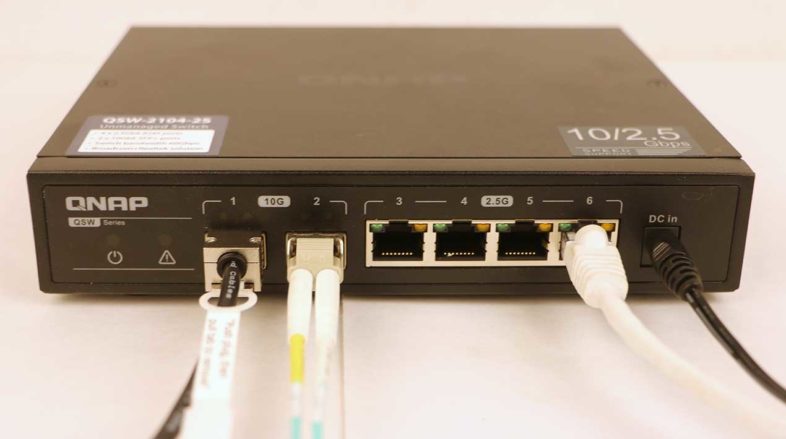My last two articles covered 10GbE networking, and how to set up a direct network connection between two computers without using a switch. Using a switch is actually much simpler, but costs more money. The good news is that we are finally getting high speed switches on the market that are small and affordable enough for nearly any user that needs connections in excess of 1Gigabit. N-BaseT has been offering hope that this would happen, but even with increasing client support, until very recently, there were no affordable switches. I first noticed 5 port 2.5G switches listed online a few weeks ago, being offered by both QNAP and Trendnet in the $120 price range, which was half the price of anything else I had previously found. I immediately decided it was time to buy one, both for this series on networking, and because it will be a useful tool in the future.
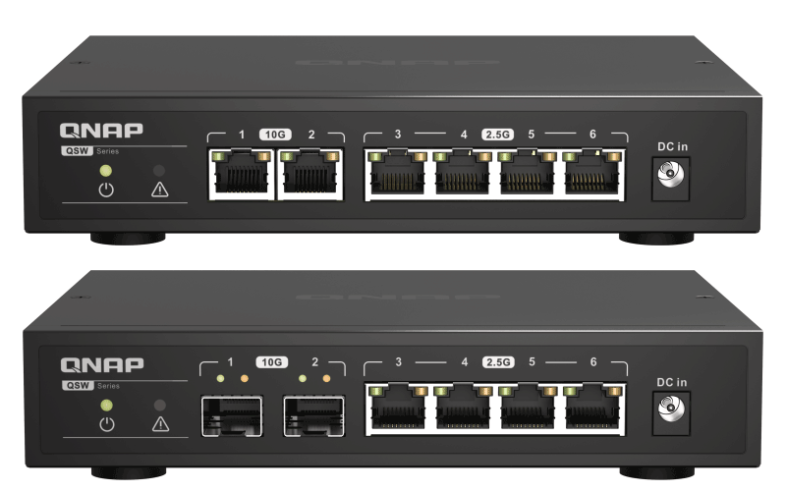 As I prepared to purchase one, I discovered QNAP had something even more exciting; N-BaseT switches with 10G ports, in the form of QNAP’s QSW-2104 switches. Besides four 2.5G RJ-45 port for CAT5 cables, the -2T variant has two 10G-BaseT RJ-45 ports, and the -2S variant has two 10G SFP ports for fiber and TwinAx connections. I could use either version in various ways, but the SFP option gives me some unique things to try, and still supports my 10G-BaseT clients, albeit at 2.5G speeds. At $140, the SFP version is $20 cheaper than the RJ-45 option, because it takes more work and energy to get 10G speed over Cat6 cables than it does to use SFP. And that same fact gives SFP connections lower latency, and they should use less power, although both versions advertise 12W max usage, which is great, since these usually run 24/7. The main benefit of 10G-BaseT is that it allows use of existing wires. N-BaseT has the same benefit to an even higher degree, with far lower costs and power requirements, at the cost of lower peak speeds that few users need. So I didn’t hesitate to order one, planning to use it to illustrate N-BaseT connections, and the benefit of switches.
As I prepared to purchase one, I discovered QNAP had something even more exciting; N-BaseT switches with 10G ports, in the form of QNAP’s QSW-2104 switches. Besides four 2.5G RJ-45 port for CAT5 cables, the -2T variant has two 10G-BaseT RJ-45 ports, and the -2S variant has two 10G SFP ports for fiber and TwinAx connections. I could use either version in various ways, but the SFP option gives me some unique things to try, and still supports my 10G-BaseT clients, albeit at 2.5G speeds. At $140, the SFP version is $20 cheaper than the RJ-45 option, because it takes more work and energy to get 10G speed over Cat6 cables than it does to use SFP. And that same fact gives SFP connections lower latency, and they should use less power, although both versions advertise 12W max usage, which is great, since these usually run 24/7. The main benefit of 10G-BaseT is that it allows use of existing wires. N-BaseT has the same benefit to an even higher degree, with far lower costs and power requirements, at the cost of lower peak speeds that few users need. So I didn’t hesitate to order one, planning to use it to illustrate N-BaseT connections, and the benefit of switches.
N-BaseT was developed as a lower cost alternative approach to exceeding 1Gigabit ethernet speeds, and it has taken a few years for it to really impact the market. The theory is that 2.5Gb ethernet should work nearly anywhere that 1Gb does, over the same Cat5e cables, at the same distances. It uses far less power than 10G-BaseT, allowing 2.5Gb NICs to be integrated into newer motherboards, and PCIe and USB adapters are about $30 to add client connections. Affordable switches were the last piece of the puzzle missing, but they are now beginning to appear. There is also a 5Gb N-BaseT standard, that is not as widely supported, that tries to split the difference, with higher cabling requirements and power needs, but still lower than 10GbE. The issue I see is that 2.5Gb is honestly enough for most users, supporting 300MB/s, and those with higher needs have probably already made the leap to full 10GbE products. So while I anticipate 2.5Gb networking growing in popularity, I do not necessarily have the same expectations for 5Gb.
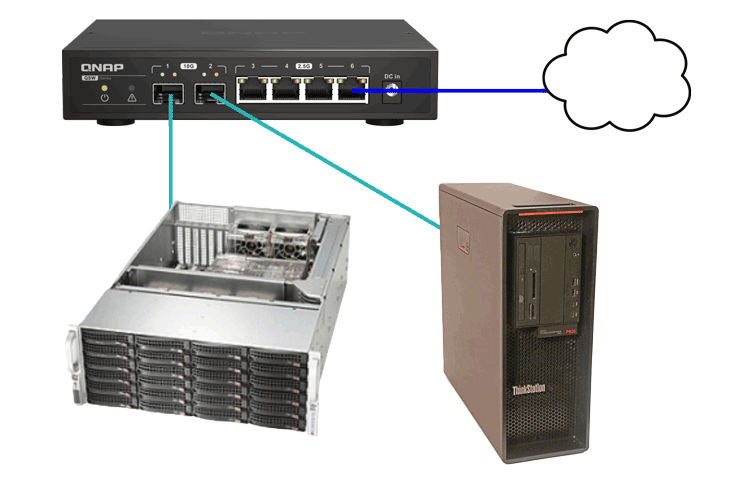 Now one might ask, what is the benefit of a switch with only two 10G ports? There are two primary use cases that come to mind. First of, if inserted in the middle of the 10GbE direct connection I outlined in my last article, it allows you to link that high speed connection to the rest of your network, and router. This results in much simpler automatic configuration, and allows your client systems to use a single interface and cable for both file transfers and internet access. (With a direct link, you have to have a separate Gigabit connection for internet and all other network service.)
Now one might ask, what is the benefit of a switch with only two 10G ports? There are two primary use cases that come to mind. First of, if inserted in the middle of the 10GbE direct connection I outlined in my last article, it allows you to link that high speed connection to the rest of your network, and router. This results in much simpler automatic configuration, and allows your client systems to use a single interface and cable for both file transfers and internet access. (With a direct link, you have to have a separate Gigabit connection for internet and all other network service.)
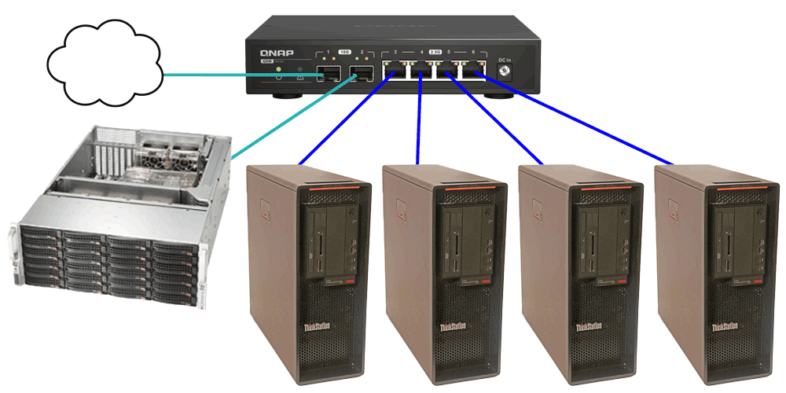
The other use case is to share a single high speed resource on the 10G link to up to four users on the 2.5G ports. 2.5G gives each user about 300MB/s, which allows uncompressed HD playback, and my media server could easily support that to four separate systems, fully utilizing the switches capability. Many existing networks already use a similar approach to share a 10G resource with many 1GbE users, or a 50G resource with 10GbE users.
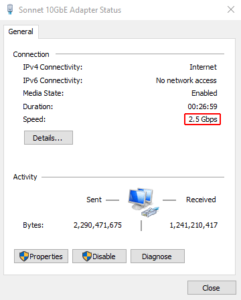 When my switch arrived, I was eager to try it out. It was as simple to install and use as any unmanaged gigabit switch. I used one of the N-BaseT ports to connect it to my existing router and network at 1Gigabit. The RJ-45 connection to the Sonnet Solo10G on my laptop yielded a 2.5G connection, which allowed me to copy files at nearly 300MB/s, while plugging an SFP+ cable into the 10G port gave my workstation 10GbE access without any further configuration. QNAP has done a great job of providing a range of products that will meet the needs of a wide variety of different use cases. I have used their 12 port 10GbE switches in larger installs for the last few years, and these smaller units are great when a small number of systems need to share data at high bandwidths. Network configuration is easy with the right products, and these new switches render my direct connections nearly obsolete. The one main case they are still useful is for links exceeding 10Gigabits, because those switches are still power hungry and expensive. We will examine one of those situations, as well as explore a number of approaches for exceeding 10GbE speeds in the last installment in this series.
When my switch arrived, I was eager to try it out. It was as simple to install and use as any unmanaged gigabit switch. I used one of the N-BaseT ports to connect it to my existing router and network at 1Gigabit. The RJ-45 connection to the Sonnet Solo10G on my laptop yielded a 2.5G connection, which allowed me to copy files at nearly 300MB/s, while plugging an SFP+ cable into the 10G port gave my workstation 10GbE access without any further configuration. QNAP has done a great job of providing a range of products that will meet the needs of a wide variety of different use cases. I have used their 12 port 10GbE switches in larger installs for the last few years, and these smaller units are great when a small number of systems need to share data at high bandwidths. Network configuration is easy with the right products, and these new switches render my direct connections nearly obsolete. The one main case they are still useful is for links exceeding 10Gigabits, because those switches are still power hungry and expensive. We will examine one of those situations, as well as explore a number of approaches for exceeding 10GbE speeds in the last installment in this series.